If we consider the reports that indicate that only one-third of American children can read proficiently, we can all agree that it is time to come together to make widespread changes in the way reading is taught.
The Science of Reading (SoR) provides the information that educators need to secure phonics as the primary approach to reading and prepare students to become fluent and independent readers for life.
Teachers who are looking to transition from a balanced literacy approach will be pleased to find a lot of information and resources available to guide instructional practices that are based on evidence. Many teachers have been accustomed to using the three-cueing system to drive reading. The goal of the three-cueing system is for students to access information sources including meaning, structure, and visual. In this approach, students are encouraged to make informed guesses at a word, use context or other knowledge and experience to plug-in unfamiliar words, and engage in independent reading of high-interest books. In most cases, teachers use the three-cueing system as a primary approach and could choose to mix in some phonics instruction when deemed appropriate. However, the research within the Science of Reading confirms that adding in some phonics instruction intermittently is not effective. Although students are exposed to reading and provided with a wealth of opportunities,  they will not develop the deep knowledge and skills that good readers possess. In fact, there have been multiple references to reveal the ways in which the three-cueing system mimics the same strategies that are used by poor readers. In addition, this type of cueing system leaves many children ill-prepared to tackle more advanced concepts in later years. Thankfully, the Science of Reading proves that we do not learn to read differently and with instruction in explicit, systematic phonics, every student can access the same knowledge and skills to become a good reader.
they will not develop the deep knowledge and skills that good readers possess. In fact, there have been multiple references to reveal the ways in which the three-cueing system mimics the same strategies that are used by poor readers. In addition, this type of cueing system leaves many children ill-prepared to tackle more advanced concepts in later years. Thankfully, the Science of Reading proves that we do not learn to read differently and with instruction in explicit, systematic phonics, every student can access the same knowledge and skills to become a good reader.
If you are new to the Science of Reading or just beginning to dive into the instructional practices that are heavily supported by research, here are just a few areas that you will want to become very familiar with to get you moving in the right direction:
Gain insight regarding the Science of Reading (SOR)
This is a compilation of many years of research that explains what scientists have confirmed about how children learn to break the code of the English language. The contributions of experts in the fields of developmental psychology, educational psychology, cognitive science, and neuroscience represent decades of studies demonstrating the essential foundational reading skills that must be mastered by all students to develop effective decoding and orthographic mapping skills. This research has important implications on how reading skills are developed and how students should be taught. The SOR dispels misconceptions about the three-cueing systems and other commonly used practices that are not supported by evidence and provides a clear direction. It further explains how we learn to read. Good readers do not struggle to guess and sound out words. They immediately recognize them. Word reading is fluent and allows them to focus on meaning-comprehension.
Do the “Math”
Get to know the Simple View of Reading
Gough & Tunmer’s (1986) Simple View of Reading demonstrates comprehension as the product of two basic components-
Word recognition (decoding) x Language comprehension = Reading Comprehension
Understanding the formula will help educators with assessing reading weaknesses and providing appropriate instruction. The Simple View formula indicates that strong comprehension cannot occur unless both decoding and language comprehension skills are strong. Word recognition is best taught through a phonics-based approach, wherein students develop knowledge and skills about how the alphabet works to become expert decoders. At each grade level, we must ensure that students have sufficient content knowledge and higher order thinking skills to understand what they read. Reading instruction must prepare them to become strong decoders to allow students to apply knowledge of the subject and synthesize the information to establish solid comprehension.
Learn the Alphabetic Principle
In an effort to be a highly effective teacher of reading, one must develop a solid understanding of the alphabetic principle. This is the systematic relationship between sounds (phonemes) and the letters that spell them (graphemes). Good readers recognize patterns in words because they know that words are made up of sounds and that each sound is represented by one or more letters. This ability to identify patterns allows students to differentiate between words that look similar, like bent, bet, and bend or imported, imparted, and impaired. This skill cannot be attained through the use of cues like guessing, access to illustrations, or a search for context.
Understand Orthographic Mapping
 A major discovery in reading research in past years has given us a solid understanding of how words are stored in our memory. The mental process that is activated to engage instant, effortless word retrieval is called “orthographic mapping”. Dr. David Kilpatrick reminds us that “Efficient orthographic mapping will only occur if the student has adequate skill in phonemic awareness and analysis”, (Essentials, p.100). The central focus of instruction is on teaching the brain to recognize patterns. Good instruction will empower the student to use linguistic vocabulary (compound word, digraph, closed syllable, blend, syllable) and identify the substructures (syllable types, spelling rules, patterns) within words. This application of skills and knowledge will allow the student to decode new words. The bank of words that can be instantly retrieved and read effortlessly is referred to as the “orthographic lexicon”.
A major discovery in reading research in past years has given us a solid understanding of how words are stored in our memory. The mental process that is activated to engage instant, effortless word retrieval is called “orthographic mapping”. Dr. David Kilpatrick reminds us that “Efficient orthographic mapping will only occur if the student has adequate skill in phonemic awareness and analysis”, (Essentials, p.100). The central focus of instruction is on teaching the brain to recognize patterns. Good instruction will empower the student to use linguistic vocabulary (compound word, digraph, closed syllable, blend, syllable) and identify the substructures (syllable types, spelling rules, patterns) within words. This application of skills and knowledge will allow the student to decode new words. The bank of words that can be instantly retrieved and read effortlessly is referred to as the “orthographic lexicon”.
Embrace Phonics Instruction
Some teachers have been influenced by the notion that phonics instruction is rote, mundane, or boring. Teachers who have been professionally trained in Orton-Gillingham will likely sing a different tune. Why? The answer is simple. When students are taught through an explicit, systematic, multisensory approach, they quickly master skills that promote word recognition and build confidence. Activation of these skills ignites excitation in the brain, allowing for fluent reading to occur and paving the way for the student to gain a deeper comprehension of text. Skilled teachers will embed practice through review and repetition cycles that are designed to enhance orthographic mapping skills. Teachers can familiarize themselves with the levels of phonological awareness development and Ehri’s Phases of Sight Word Development to establish a developmentally appropriate reading program. Opportunities to engage in nonsense word reading, word structure analysis, word study, and phoneme awareness activities will all promote mapping. In addition, the selection of appropriate reading materials (decodable and controlled text) is important and will provide opportunities for the student to apply decoding strategies to mastery and gain confidence.
Build Fluency
When students are able to recognize words accurately and automatically, they can focus on other aspects of the text to generate meaning. This requires repeated exposure and multiple opportunities to apply learned decoding strategies, recognize irregular words, and activate orthographic mapping skills.
It can be challenging to shift gears from one instructional approach to another. There is no dispute about the value of contextual cues in assisting students to generate meaning from text. We continue to promote the student’s attention to the construction (syntax) and meaning (semantics) of the text to enhance imagery and comprehension. These cues are perfectly appropriate when used to supplement the phonetic process (rather than replace it). But what happens when the pictures are gone and the fourth-grade student is no longer provided with visual cues? Thankfully, an inherent goal of teaching is to ignite a student’s love for learning and to promote the success of every student. Good teachers are constantly searching for effective teaching practices and building their knowledge upon the research that supports learning. By embracing the Simple View of Reading, teachers will be able to shift the instructional focus to evidence-based practices which will build a foundation that will empower students and ultimately allow them to read at more advanced levels.
As Louisa Moats said, “Reading failure can be prevented in all but a small percentage of children.” In recent years, scientists have made great strides in understanding how students learn to read and also how to prevent and correct reading problems. These findings are exciting and provide information that will foster reading development in good readers and in those who encounter problems with reading. Having access to this information warrants an interdisciplinary call to action, wherein teachers, parents, and policymakers begin to collectively embrace the Science of Reading to bring about better outcomes for the future of reading instruction and student performance. IMSE’s professional, comprehensive training empowers teachers with the knowledge of the Science of Reading, instructional strategies, and resources to feel confident in delivering evidence-based reading practices to all students.
References
Gough, P. and Tunmer, W. (1986). Decoding, reading, and reading disability. Remedial and Special
Education, 7, 6-10.
Kilpatrick, D. A. (2016). Equipped for Reading Success. Syracuse, NY: Casey & Kirsch Publishers.
About The Author
 Dr. Kirstina Ordetx is a Level 4 Master Instructor with The Institute for Multi-Sensory Education (IMSE). She holds a doctorate in Counseling Psychology with a concentration in pediatric neurology. Dr. Ordetx is an educational specialist with over 25 years of clinical experience, research, and consultation. She is a certified Structured Literacy Dyslexia Interventionist through the Center for Effective Reading Instruction, a Certified Nutrition and Wellness Consultant, Executive Functions Coach, and a registered Licensed Mental Health Intern. Dr. Ordetx has published two books that compile her research and practice in Theory of Mind. She has served on accreditation committees for the Florida Council of Independent Schools, is a university adjunct professor in developmental and child psychology, and presents at various national and international conferences. Dr. Ordetx is head of school for a private academy in Lakewood Ranch, Florida specializing in the multi-sensory education of students who have language and learning-based differences. She is the Executive Director of the Pinnacle Pediatric Therapy Group, a multi-disciplinary, pediatric therapy clinic.
Dr. Kirstina Ordetx is a Level 4 Master Instructor with The Institute for Multi-Sensory Education (IMSE). She holds a doctorate in Counseling Psychology with a concentration in pediatric neurology. Dr. Ordetx is an educational specialist with over 25 years of clinical experience, research, and consultation. She is a certified Structured Literacy Dyslexia Interventionist through the Center for Effective Reading Instruction, a Certified Nutrition and Wellness Consultant, Executive Functions Coach, and a registered Licensed Mental Health Intern. Dr. Ordetx has published two books that compile her research and practice in Theory of Mind. She has served on accreditation committees for the Florida Council of Independent Schools, is a university adjunct professor in developmental and child psychology, and presents at various national and international conferences. Dr. Ordetx is head of school for a private academy in Lakewood Ranch, Florida specializing in the multi-sensory education of students who have language and learning-based differences. She is the Executive Director of the Pinnacle Pediatric Therapy Group, a multi-disciplinary, pediatric therapy clinic.
Sign up for our LIVE virtual Orton-Gillingham training! We are now offering half-day, evening, and weekend options to best fit your schedule.
The IMSE approach allows teachers to incorporate the five components essential to an effective reading program into their daily lessons: phonemic awareness, phonics, vocabulary, fluency, and comprehension.
The approach is based on the Orton-Gillingham methodology and focuses on explicit, direct instruction that is sequential, structured, and multi-sensory.
It is IMSE’s mission that all children must have the ability to read to fully realize their potential. We are committed to providing teachers with the knowledge and tools to prepare future minds.
Please connect with us on Facebook, Twitter, and Pinterest to get tips and tricks from your peers and us. Read the IMSE Journal to hear success stories from other schools and districts, and be sure to read the OG Weekly email series for refreshers and tips.
